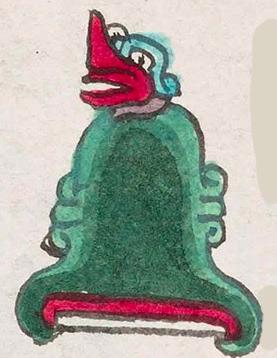Ecatepec (Mdz12r)
This compound glyph for the place name Ecatepec (or perhaps Ehecatepec) has two key elements. One is the profile of the head of the representation of the divine force of the wind and day sign in the calendar (Ehecatl), with its large red beak beak (what some sources describe as a duck bill), turquoise-blue head, and white eye. This figure is shown in profile looking to the viewer's left. The head sits atop a classic hill or mountain (tepetl) with its two-tone green bell shape, its red and yellow horizontal stripes near the base, and its curly rocky outcroppings on each slope. The locative suffix (-c) (as given in the gloss) is not shown visually, but it combines with -tepe- to form -tepec, a visual locative suffix meaning "on the hill" or "on the mountain."
Stephanie Wood
Air is ecatl and wind is ehecatl (reduplicated). If the deity is not intended, he may be there to provide a phonetic value for ecatl. A great many glyphs in this collection start with Eca- when one might expect Eheca-. We are preserving the proclivity of the gloss for Eca-, while also pointing to the likelihood of an unintentional oral abbreviation of Eheca- to Eca-.
Stephanie Wood
Ecatepec. puo
Ecatepec (or perhaps Ehecatepec)
Stephanie Wood
c. 1541, or by 1553 at the latest
Stephanie Wood
mountains, hills, montañas, cerros, deidades, deity, wind, viento, aire, nombres de lugares

eca(tl), air, breath, https://nahuatl.wired-humanities.org/content/ecatl
eheca(tl), wind or the wind deity, https://nahuatl.wired-humanities.org/content/ehecatl
-tepec, on the hill or mountain, https://nahuatl.wired-humanities.org/content/tepec
Codex Mendoza, folio 12 recto, https://digital.bodleian.ox.ac.uk/objects/2fea788e-2aa2-4f08-b6d9-648c00..., image 34 of 188.
The Bodleian Libraries, University of Oxford, hold the original manuscript, the MS. Arch. Selden. A. 1. This image is published here under the UK Creative Commons, “Attribution-NonCommercial-ShareAlike 3.0 License” (CC-BY-NC-SA 3.0).






